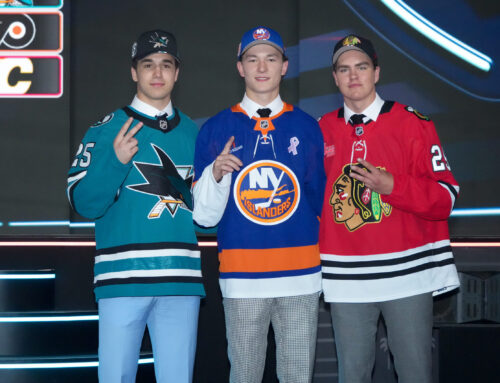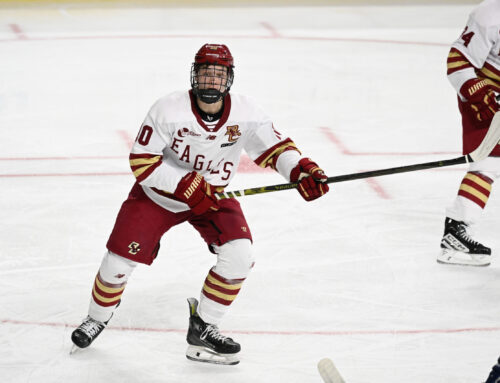Welcome back to The Journey, where we track the development of prospects as they excel in junior, make the NHL, and push towards stardom.
***
Dallas prospects Logan Stankoven and Mavrik Bourque have taken the American Hockey League by storm this year. They have been the top two AHL scorers for a while now, nearly ten points clear of third place currently. As blue-chip prospects taken in the second and first rounds respectively, both look primed to make their NHL debuts in the near future and will more than likely stick with Dallas once they do so. (Editor's note: Stankoven may make his NHL debut on Saturday.)
Kicking around in the AHL top ten, however, is a familiar group of aging AHL all-stars who consistently dominate the minors but then seemingly can't hack it at the highest level:
– Trey Fix-Wolansky (age 24; 186 points in 212 AHL; 3 in 16 NHL)
– Mark Jankowski (age 30; 154 in 159 AHL; 94 in 329 NHL)
– Rocco Grimaldi (age 31; 341 in 408 AHL; 67 in 203 NHL)
– Kole Lind (age 25; 210 in 293 AHL; 8 in 31 NHL)
– Adam Gaudette (age 28; 106 in 125 AHL; 79 in 220 NHL)
– Michael Sgarbossa (age 32; 436 in 574 AHL; 18 in 73 NHL)
– Joseph Snively (age 28; 155 in 200 AHL; 11 in 27 NHL)
– TJ Tynan (age 32; 568 in 619 AHL; 1 in 21 NHL)
– Nic Petan (age 29; 281 in 278 AHL; 35 in 170 NHL)
– Andrew Poturalski (age 29; 407 in 452 AHL; 2 in 6 NHL)
The list goes on and on. I went back over the last five years, looking at point-per-game (or close) AHL players, and the ten guys just listed show up consistently at the top of the heap in varying orders.
Also shoutouts to Seth Griffith, Alex Barre-Boulet, Drake Cagguila, Christian Wolanin, Lucas Carlsson, Lane Pederson, Kiefer Sherwood, Reid Boucher, Lias Andersson, Tyler Benson, Riley Damiani, and Gerald Mayhew.
Scattered every year amongst these AHL lifers are young, up-and-coming talents like Stankoven, Bourque, Matt Coronato (CGY), JJ Peterka (BUF), Shane Wright (SEA), Olen Zellweger (ANA), Jonatan Berggren (DET), Kirill Marchenko (CBJ), Jack Quinn (BUF), Lukas Reichel (CHI), Joshua Roy (MTL), Peyton Krebs (BUF), Nicholas Robertson (TOR), Fabian Lysell (BOS), Trevor Zegras (ANA), Tommy Novak (NAS), Drake Batherson (OTT), and Josh Norris (OTT).
And then there are guys that still might end up going one way or the other: Emil Bemstrom (PIT), Matthew Phillips (PIT), Georgi Merkulov (BOS), Ruslan Iskhakov (NYI), Philip Tomasino (NAS), Grigori Denisenko (VGK), Arshdeep Bains (VAN), Vasily Podkolzin (VAN), etc.
So, that's the situation on the surface of it: scoring the lights out in the AHL is no guarantee of NHL success. I constantly check in on the AHL scoring race to see which young rookie pros are excelling in that environment—after all, it is the second-best league in the world in terms of updated NHLe metrics—but when I do so, I'm mentally filtering out all the "dead" fantasy assets I listed above, the guys that are seemingly always a point-per-game, sometimes even leading the entire AHL in scoring, and yet never have even a trace of fantasy value.
What's with that? After digging into this question a bit, here are some thoughts on how to interpret and contextualize AHL production.
First of all, the AHL as a league has inherently split priorities. They are explicitly a farm system for the NHL, but they also have fans and profit margins and want to win. Every AHL team has to manage this push-pull dynamic, and although I don't know the league well enough to say where each team falls, every club is somewhere on a spectrum between these two priorities.
Some coaches have a green light from upper management to run their team in a developmentally appropriate way, while others are under pressure to win games and make the playoffs. As Andrew C. Thomas put it years ago on The Hockey PDOcast, that means some coaches are thinking, "How do I get the most out of this player right now?" while others are thinking, "What is this player going to look like four years from now?"
The first approach (win now) involves icing the most competitive club and running the most effective systems every night—even if that means you lean on a bunch of 30-year-olds to play the trap or something. If 30-year-old Mark Jankowski is more likely to score than 20-year-old Joakim Kemell, Jankowski goes out for an offensive zone draw while Kemell sits.
This approach also means explicitly aiming to reduce mistakes and limit creativity. Don't try to dangle two defenders, just dump and chase, dump and chase. Make the safe play. God forbid you try a Michigan! While that can instill pro-level habits to some extent, it also reduces the developmental aspect for young players. Exploring creativity and learning from mistakes are crucial for players trying to make it at the highest level of the sport.
As Dobber Prospects' Director of North American Scouting, Hadi Kalakeche, argues, the AHL is a poor developmental league overall.
To me, that is an absolutely jaw-dropping insight because I feel like the general perception out there is entirely the opposite. A prospect on my fantasy farm team just graduated from college or came over from Russia after a couple years and is going to the AHL next year. Awesome! Now we'll be able to see what we have here. If he's legit, he'll put up points right away in the AHL, get called up, and never look back. It's better to have him in the minors than anywhere else.
This links back to my point last week about the infamous three-year Matvei Michkov contract. (Tl:dr – it's already one-third over, many of his 2023 peers are on a similar timeline, and he'll cross over to North America at age 21 with four years of pro-level experience, ready to dominate right away.) There certainly is a ton of suspicion towards Russia still in the West, which is a whole different conversation/history lesson. But if the AHL truly is this poor as a development league, maybe staying in Russia is a decent idea for many of these prospects, despite all the bad press.
***
As much as there is a pushback in the fantasy community towards stat-based projection models, I think one of the biggest factors that can help managers distinguish between AHL lifers and up-and-coming NHLers is the age at which they achieve high-level AHL (or junior) results.
Having spent years with these models now, I'm consistently astounded at how brutal they can be with overage production. The same incredible production in the OHL, for instance, from a 20-year-old versus a 19- or 18-year-old makes a world of difference.
An example:

I wrote about both Amadeus Lombardi (DET) and Matthew Maggio (NYI) towards the end of last season because they finished third and first respectively in the 2022-23 OHL scoring race, both cracking the century mark and dominating their peers. HP creator Byron Bader has referred to a 40 NHLe as a bit of a magic number that generally prefigures NHL success—but it all depends when players hit it. By their Draft+2 year, it's already too late in most cases. Lombardi and Maggio have both struggled transitioning to the AHL this year. They might still make the show, but historically speaking, their chances of becoming fantasy-relevant, star-level producers are basically nil.
Now here are two of the names I listed above in the "might still make it" category.

Again, both brushed up against the 40 NHLe mark with impressive Draft+2 campaigns. Bemstrom won the SHL goal scoring title while Phillips dominated the WHLer as a double overager. At the time, the statistical achievements certainly seemed notable and both players had some fantasy buzz.
Then they both made the jump to North American pro hockey and crushed it. Bemstrom put up 20 points in 56 NHL games as a rookie, and Phillips scored 38 points in 65 AHL games. In the ~four years since, Bemstrom went over a point-per-game during a short stint in the Liiga during Covid and recorded an insane 47 points in 33 AHL games, while Phillips put up 198 points in 199 AHL games. Impressive stuff.
But then Bemström averaged a 27-point pace over his next 148 NHL games with Columbus (now with PIT) while Phillips (also now with PIT) managed only five points in 33 NHL games with three different clubs.
Let's dig a bit deeper with Bemström in particular because his AHL production at a fairly young age seemed particularly prolific. This year with the Blue Jackets, he was the second-most heavily sheltered player in the entire team after his most common linemate Kent Johnson. Nevertheless, both players still posted poor-to-average play driving results.

Bemström was always billed as a fast north-south skater with an above-average shot and great scoring instincts. I always felt some trepidation with him in fantasy, though, because he seemed too one-dimensional, and that seems to have been the case in the end. A player like him that needs strong linemates, offensive deployment, AND heavy sheltering is not likely to make it in the NHL, especially when he's already 24 years old and a former fourth-rounder. Although Johnson has been demoted and benched at times, he is a high first-rounder and still only 21. He has time to figure this out still. As the trade to Pittsburgh indicates, Bemstrom ran out of time—right as he was passing his 200-game Breakout Threshold too.
I would not bet on Bemström (or Phillips, for that matter) finding a new gear in Pittsburgh. While the AHL stats look flashy, they were largely a result of receiving top-line, top-power play, maximum offensive zone start deployment. I don't know enough about their specific minor league teams and coaching staffs to say whether they were developed properly or improperly in the AHL. But while receiving AAA-grade offensive deployment might have allowed their offensive tools to shine through, it seems like the other parts of their games—the two-way, pro-level habits—did not progress far enough during their AHL tenures to adequately prepare them for NHL success.
***
On top of age, one-dimensionality, and pedigree, another primary factor in the failure of many of the AHL lifers listed above seems to be size. Despite the game opening up more in recent years to smaller players, it remains a harder hill to climb for guys under maybe 5-10 or so.
Emil Bemstrom: 5-10
Matthew Phillips: 5-7
Trey Fix-Wolansky: 5-7
Rocco Grimaldi: 5-6
Joe Snively: 5-9
TJ Tynan: 5-9
Nic Petan: 5-9
Seth Griffith: 5-9
Ruslan Iskhakov: 5-8
Alex Barre-Bouley: 5-10
Valtteri Puustinen: 5-9
There are exceptions all over the place, of course, including 5-8 rookie scoring leader Logan Stankoven, but the point is that if a prospect is offensive one-dimensional, was drafted past the second round, is under six feet tall, peaked/broke late (D+2), and are now putting up a point-per-game in the AHL, the odds are they're not going to light up the NHL with fantasy-relevant production. Trade them if you can on the basis of their gaudy totals in the second-best league in the world and the potential that they could replicate that success alongside their pro team's superstar. Aim to acquire a younger player posting similar results at a younger age.
Prospects are always a bit of a crapshoot, but those general principles should help you slowly accumulate greater value over time on your farm team.
***
Thanks for reading! Follow me on X @beegare for more prospect content and fantasy hockey analysis.





 EDM
EDM STL
STL ANA
ANA BUF
BUF DET
DET NYI
NYI MIN
MIN CAR
CAR VAN
VAN S.J
S.J
